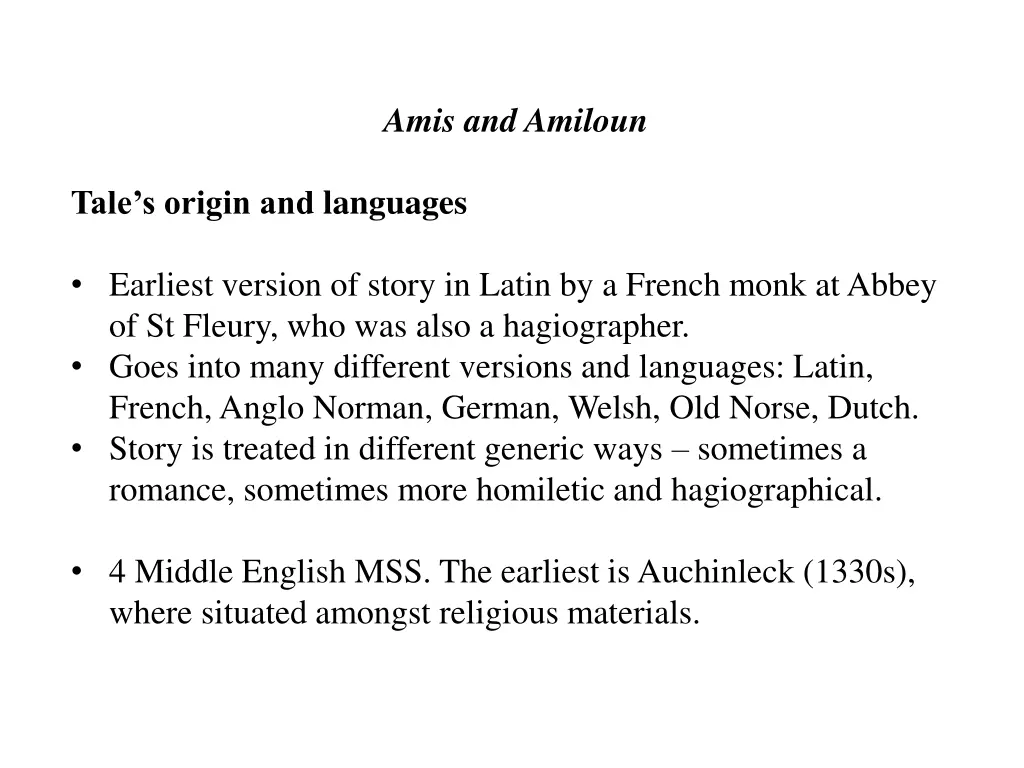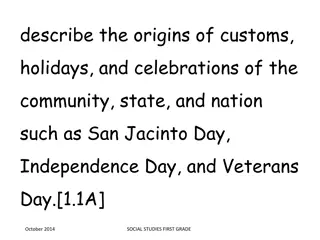
Origin & Evolution of Amis and Amiloun Tale Across Languages
Explore the origins and development of the Amis and Amiloun tale, originating in Latin and spreading to various languages like French, Anglo-Norman, German, Welsh, Old Norse, and Dutch. The narrative, at times a romance or homiletic/hagiographical, delves into themes of male pairs in saints' legends and sworn blood-brotherhood with Nordic origins. Dive into how the romance critiques or glorifies the power of brotherhood, intertwining earthly and spiritual dimensions, similar to Sir Gawain and the Green Knight's exploration of treuthe.
Download Presentation

Please find below an Image/Link to download the presentation.
The content on the website is provided AS IS for your information and personal use only. It may not be sold, licensed, or shared on other websites without obtaining consent from the author. If you encounter any issues during the download, it is possible that the publisher has removed the file from their server.
You are allowed to download the files provided on this website for personal or commercial use, subject to the condition that they are used lawfully. All files are the property of their respective owners.
The content on the website is provided AS IS for your information and personal use only. It may not be sold, licensed, or shared on other websites without obtaining consent from the author.
E N D
Presentation Transcript
Amis and Amiloun Tale s origin and languages Earliest version of story in Latin by a French monk at Abbey of St Fleury, who was also a hagiographer. Goes into many different versions and languages: Latin, French, Anglo Norman, German, Welsh, Old Norse, Dutch. Story is treated in different generic ways sometimes a romance, sometimes more homiletic and hagiographical. 4 Middle English MSS. The earliest is Auchinleck (1330s), where situated amongst religious materials.
Male pairs in saints legends Sheila Delany relates this story to pairs of male saints who make common vow of Christian fidelity in saints legends of the early church: Cyprian and Justinus, Cosmas and Damian, Cyril and Methodius, 14 male pairs in the Golden Legend (main Latin collection of lives of saints throughout Middle Ages) Commonly these pairs share fidelity to a vow, may undergo exile and poverty, die together and are buried in same grave. One pair, Serge and Bacchus were said to resemble one another greatly. Another pair, Polyeuct had such boundless love for Nearchos, he would not even spare his children for sake of Nearchos. S. Delany, A,A and B: coding same-sex union in Amis and Amiloun , N. MacDonald (ed.), Pulp Fictions of Medieval England (Manchester, 2004), pp. 63-81.
Sworn blood-brotherhood Nordic origins. By 14th c such ideals viewed with dubiousness. Paul Strohm: such oaths held for the medieval sensibility a possible implication of connivance and dubious alliance, of self-advancement that neglects the total Christian community. Chaucer s references to blood-brotherhood in Canterbury Tales Friar s Tale: blood-brotherhood pact made between the devil and a summoner. Summoner so morally dead he doesn t realise he is making a blood pact with the devil. Eventually taken to hell by devil. Pardoner s Tale: sworn blood-brotherhood between the 3 drunken revellers. The 3 use their bond to sin and steal together, and eventually turn murderously against one another. Shipman s Tale sworn brotherhood between Monk and Merchant. This bond betrayed by the monk, who borrows money from merchant without intent to repay, and sleeps with his wife.
Overall, does the romance criticise the power of the bond of brotherhood, or glamourise it by giving it a certain likeness with religious fidelity and sacrifice? Or, does it show the bond of brotherhood concomitantly serving both earthly and spiritual ends? Like SGGK, does A&A question the propriety of envisioning the pledge of treuthe as an absolute value to the exclusion of all others?






















